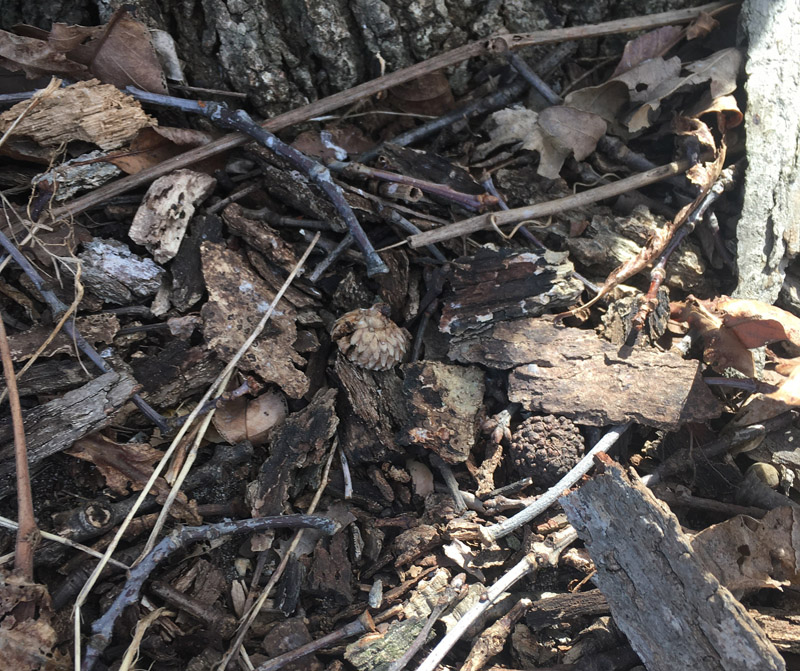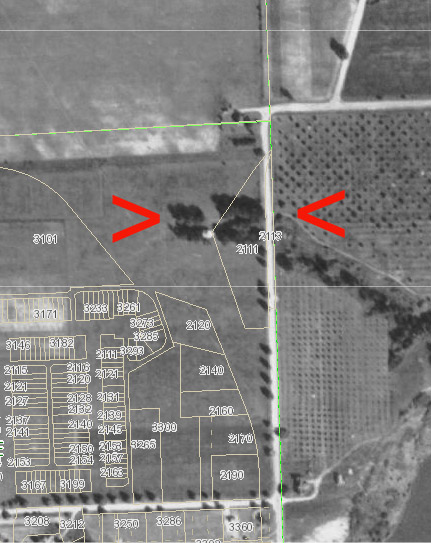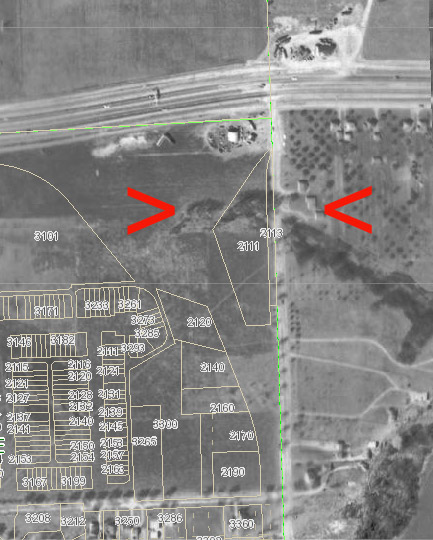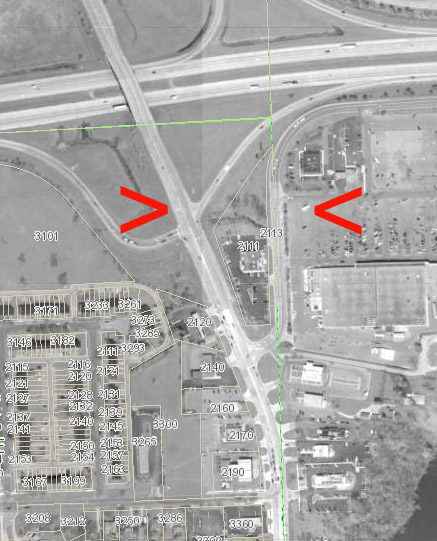In a sufficiently inattentive world, sometimes the best place to hide is in plain sight.
In fact, it is quite common for a singularly beautiful thing to be discovered existing quietly, off to some neglected corner of a world that affords little interest in its presence, much less in its beauty. It makes a thoughtful person wonder what sort of practical matter — because in our world, it’s almost always a practical matter — has inadvertently stepped in, shielding it from the pragmatic pursuit of progress that permeates every other corner of our society.
A tiny space to live
At 2100 S Interstate 94 Service Drive, near Belleville, Michigan, a grove of improbably large trees has thrived for well over a century, on a tiny plot adjacent to a senescent shopping center that is already poised to complete its own life cycle. Hemmed in on every side by concrete roadways and creeping suburban sprawl, this grove has persisted since its roots first found the soft earth of a wayside creek at the edge of an early rural homestead, on a road that has since been routed away. To what long-lost scenes does it bear silent witness, as thousands of absent minds drive past, every day, today?

A curious presence
I first noticed this grove on an otherwise unremembered summer day, when its bushy green canopy, towering over the surrounding nondescript commercial sprawl, was lit flatteringly by a golden morning sun as its leaves quaked silently in the breeze. I would notice this grove several times again. Each time, I became more curious about its origin, significance, and likely fate.
This was the kind of precarious situation that I usually associate with the habits of the Eastern Cottonwood, Populus deltoides. Considering that cottonwoods are opportunists that can grow very large very quickly, I assumed that these were cottonwoods that had simply sprung up sometime during my lifetime, and were continuing to make the most of an opportunity to grow in a temporarily neglected place, one that had not yet found the right investor to convert it into yet another fast-food outlet. This species thus is one of the more frequent sufferers of the collateral damage that accompanies many otherwise well-considered property investment decisions.
However, as a botanist friend says, “Botany cannot be done from a car.” On this late-winter day, after a year of toying with the idea, I finally got out of my car to take a look.
It was quite easy to find a parking spot in the forlorn shopping center across the street. When I was a child, the Lakewood Shopping Center hosted a modern K-Mart department store and more than a dozen smaller shops, anchored at the other end by the largest supermarket in the area and a popular chain drugstore. After a long, gradual decline punctuated by the exit of most of the other shops, the K-Mart finally departed a couple of years ago. On this Friday afternoon, one might have counted about 12 cars on the entire property, half of them probably belonging to the employees of the cluster of marginal shops that remain huddled in the corner. This center was built in 1973 — unbelievably, on top of a small stream that had emptied into the Huron River before this project relegated it to the underground. Today, the stream continues to burble through its designated passage, disappearing into the darkness of a deep culvert at the edge of the grove, and proceeding invisibly under an indifferent surface of spent asphalt.

After snapping the picture above, I turned 180 degrees to face my quarry, the grove across the street. After snapping two pictures, I began to wonder — are these really cottonwoods? I proceeded across the street for a closer look. Owing to the lack of shopper attraction, there was only spotty traffic on this four-lane street, most of whose traffic left permanently with the K-Mart. I scrambled across and nonchalantly made my way into the bush. The goal was to identify the trees.
In the month of March, the task of tree identification offers little to go on but bark and leaf litter. Glimpsed from a moving car, the growth habit of these trees, bare of leaves, looked a lot like cottonwood to my untrained eye. But being now stationary, and on foot, I could tell instantly that these were not cottonwoods, due to the lack of smooth upper bark. But what were they?
My second guess was oak. Looking at the leaf litter at the base of one of the trees, I did indeed see some acorn caps.

Looking again a few feet away, the dried oak leaves confirmed it. To me, they look like White Oak, Quercus alba, but I’ll wait until summer to decide. There seemed to be some other types of debris too. At the bottom of the picture below, one can see a curious, straight-edged, reddish-brown husk that does not look very acorn-like.

Looking a bit further, I found a bare spot of dirt near the base of another tree, a sort of squirrely shell midden. The large nut shells are definitely not acorns – hickory nuts, probably. But the much smaller spherical shells, scattered about them, have me completely puzzled. Obviously, they are attractive to the squirrel or whatever other animal was collecting them, because every one is carefully gnawed open. They seem much too small to be acorns, at about 3/8 inch in diameter, and lack the typical features. Perhaps when the leaves come out soon, I’ll be able to make a better judgment.

Below, we see another of the trees, one that resembles a hickory, with its somewhat shaggy bark – possibly shellbark hickory, Carya laciniosa. Interestingly, there is also what appears to be an American Bittersweet vine running up its trunk. I was pleased to see that it does not seem to be the heinous, invasive Oriental Bittersweet, which I have written about before — primarily because it does not seem to be strangling the tree. I was prepared to sever its greedy tendrils if it was.

Taking measure
Knowing now that these were likely a mix of oak and hickory, it meant that this grove, given the size of the trees, must be significantly old – a lot older than I had assumed. But how old might it be?
The next day, I went back with a rope to see if I could measure the diameter of one of the trees. I chose one that looked like an oak. At breast height its circumference was about 102 inches (2.6 meters), giving it a diameter of about 32 inches. Various sources online suggest that the age of an oak can be roughly estimated by multiplying the diameter in inches by a “growth factor” between 4 and 6, depending on the species of oak. Although I have not yet identified the species, I can rule out those such as Pin Oak that have a growth factor less than 4. Assuming 4, this tree would be 128 years old – placing its birth in the 1890s. If it’s white oak (as I suspect), a growth factor of 5 would date it to the 1860s. Still little more than a guess, of course.
As for the one whose bark made me think it could be a hickory, it seemed to look like it could be a Shellbark Hickory. I could not find a growth factor for it, but its cousin Shagbark Hickory (Carya ovata) is commonly described online as the “fastest growing hickory” — and its growth factor is a whopping 7.5. So if really was a hickory, and had the same diameter as the white oak, it could date back to the 1780s – or 240 years ago!
Time will tell
For the rest of that winter I nurtured that enticing possibility in the back of my mind. Finally, it became spring, and I returned to take a look at the emerging leaves, and see if it really was a very old hickory. But it seems as if all of the ancient trees in this grove are not hickory but in fact Quercus alba, or Eastern white oak, as I’d half suspected.

But it didn’t answer where those hickory shells came from. These trees have a very high canopy, so I was able to inspect the leaves only on a few low-hanging boughs. As I squinted upwards, I was unable to spot any leaflet arrangements that look like hickory. A bit further on, there were a number of smaller trees with leaflets that could be hickory, but it was not easy to access this area, so I did not inspect further. It’s safe to assume the squirrel has been getting those hickory nuts from somewhere nearby — and that is probably where.
Proof of persistence
Now that we know that this is a grove of white oaks, it means they could date to the 1860s. This is when the nearby ghost town of Rawsonville was at its peak. Could this grove possibly have persisted for that long a time?
It’s hard to believe, but based on the diameters of the trees, it seems possible. If true, then a grove must have persisted here throughout the 20th century. I looked at some old aerial photos for confirmation. I wanted to have a visual for how this grand grove might have stubbornly persisted over the years.
1940
Unfortunately, aerial photos do not go back to the 1800s. But in the view below, from 1940, we can see that this was already a mature grove, 82 years ago. Unlike the rest of the surrounding land which was being intensively farmed, these trees remained undisturbed, shading the headwaters of a small creek that trails off to the lower right. Most likely, this was a low and moist spot, considered not to be farmable. The creek is shadowed by a diagonal line of trees, separating two orchards, as it meanders toward Belleville Lake. At that time, a small creek like this would likely have hosted crayfish and various migratory minnows that must have delighted generations of young children nearby on Saturday afternoons. Rawsonville and Grove Roads (center and bottom) are both lined with regularly-spaced, and quite mature, trees. It suggests that this large parcel of land was given significant attention by one of its earliest owners.

This and the later aerial photos came from the MapWashtenaw site.
[Note: the property lines are today’s.]
1960
By 1960, the grove continues to persist, even as the I-94 freeway has been built just to the north. Some small houses have sprung up on the outlots of the orchard property, but by and large the area is still rural, except for the spoliations of the freeway. The large trees that line Rawsonville and Grove are still there. It must have been a nice drive.

The present
By 2002 when the photo below was taken, the area had reached its present state, more or less. We now see the shopping center to the right, constructed in 1973. Rawsonville Road has been rerouted on a diagonal to the upper left, and ramps constructed. Thus, the old, tree-lined north-south segment of Rawsonville Road survives only as a segment of the I-94 Service Drive. This realignment and the eastbound on-ramp obliterated the west part of the grove. But the rest of the grove persists. We can only imagine the small creek and the orchards, their memory erased by acres of pavement. The trees that once lined the roads are all gone.

Staying power
Thus it is that circumstances can sometimes cause a small bit of the native forest to find itself at the unlikeliest address. Both the 20th and the 21st centuries have provided similar opportunities, in the form of economic inefficiencies, for such things to happen. In 1940 and before, it was the inconvenience of farming a low spot near a creek. After 1960, it was the encroachment of the eastbound on-ramp, along with the bisection of the lot by the remaining part of the creek, that together prevented the north side of the lot, where the grove lives, from being large enough to easily build upon by 21st century standards.
Thus the grove persists, even as the human activities that would have displaced it enter a spiral of decline. Having already outlasted a culture of intensive farming, this grove now seems well on its way to outlast a culture of intensive development. The Lakewood Shopping Center, the K-Mart Corporation that occupied it, and the status of this area as a shopping mecca, all seem less healthy than this grove. What else might it outlive?
Driving past today, one can see not only a few trees adorning a backdrop of asphalt and jaded buildings — but also, with some imagination, the last remaining edge of a wayside country road of long ago — fronting, we might imagine, not a freeway, but an expansive, golden field of wheat, that it discreetly withholds from our view.
It is a lucky grove, indeed.
Article and photos Copyright 2022.
To be notified of new articles, visit https://whatshallweweird.com/subscribe/



2 Comments
William J Eyler
This was AWESOME! I’ve often wondered about that grove left there. So interesting to know it’s the last remnant of a bygone era!
Mike
Thanks William! I also heard from another reader who remembers visiting the little stream as a child. Hard to believe these trees and the stream still survive!